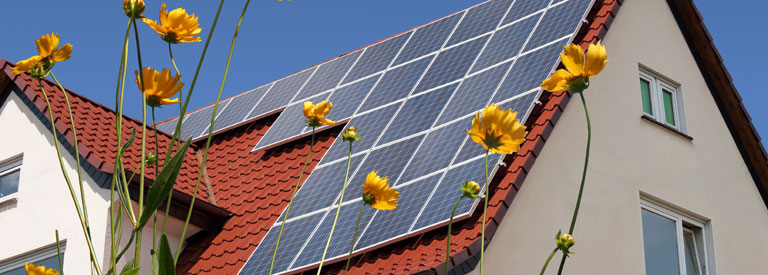Choosing the right solar panels
There is a huge range of panels available on the market for any prospective PV system owner. All have their merits be it high performance or low cost. In this section I will identify certain criteria to consider when choosing your panels. The first step is to understand the types of solar cells from which a panel/module is comprised.
To compare the typical costs of installing these different solar panels, please read our Price Guide.
View our solar panel price guide Free estimate for solar panel installation Contact our friendly team
The majority of PV cells are manufactured from Crystalline Silicon, mainly due to the abundance of Silicon compared to other suitable elements. Crystalline Silicon panels are readily available for purchase and come in a variety of technologies:
• Polycrystalline Silicon
• Monocrystalline Silicon
• Amorphous Silicon
• Hybrid
Polycrystalline
• 13-16% efficiency
• Square cells
• 0.24-0.3mm cell thickness
• Frost pattern cell appearance as individual crystals are visible
• Blue
• Least expensive readily available panel type
Monocrystalline
• 15-20% efficiency
• Round, semi round or square cells
• 0.2-0.3mm cell thickness
• Uniform Appearance
• Dark blue, black or grey (with anti-reflective coating) colour
Amorphous Silicon Cells
• 5-7% efficiency
• Amorphous thin film applied to a low cost substrate
• Thickness dependent upon substrate
• Uniform appearance
• Reddish brown, blue or blue violet colour
• Not recommended for domestic installations
Hybrid Cells
• 19.4% efficiency
• Square cells
• 0.2mm cell thickness
• Uniform appearance
• Very dark blue – black colour
• Premium panel
• Monocrystalline panel with amorphous thin film
It is worth mentioning that panels are tested under standard test conditions of 1000W/m2 irradiance, 25oC temperature and Air Mass AM = 1.5. Amorphous cells will tend to perform proportionally better than mono/polycrystalline cells in low light conditions. As a result, hybrid cells can be expected to produce an additional 7% of their estimated annual yield based on their STC rating.
Four Key Criteria when choosing solar panels
Aesthetics
The choices in panels can be quite limiting as the cell colours currently offer a fairly narrow range of options – blue (polycrystalline) or black (monocrystalline or hybrid). However, two areas where you can make a choice are the frame (silver or black finish) and the backing sheet (white or black). Most of our clients tend to prefer black frames. Backing sheet comes down to personal preference although having a white backing sheet as opposed to black can help with heat dissipation during the hot summer months. A panel will work best in high irradiance and low temperatures, therefore if you do not have a preference for the backing sheet colour then I would recommend white.
Aesthetics is very important with a solar panel installation. They’ll form part of your home, so make sure to choose something that you like!
Warranty
The product warranty is how long the manufacturer will guarantee their workmanship, the performance warranty indicates the panels performance over its lifetime. There is a huge range of workmanship quality in panels and it is not always best to go for the cheapest option. Another issue to consider with warranties is their ‘bankability’. Will the company giving you the warranty still be around in a few years for you to claim if you need to? Long warranties can be misleading and it is often best to check quality first.
Value
This is subjective, though it is important to consider that a solar PV installation will be an initial outlay of several thousand pounds so to get a better quality panel for a few hundred more could be considered worthwhile in the long term. Money comparison sites can be very useful in getting feedback on your quotes and comparing them with other people who have had installations.
Efficiency
I’ve left this to last as, although it is important, the panel efficiency is not always the most crucial element. As discussed a hybrid panel may be rated at an efficiency of <20% under standard test conditions. However, they will perform better throughout the year and thus generate above their estimated rating. For most domestic systems on single phase the sweet spot system size to target for your feed in tariff payments is 4kW. If you have plenty of roof space a higher efficiency panel (in terms of W/m2) is probably not needed. On more constrained roof spaces, the panel efficiency can make a huge difference (e.g. the difference between having a 3kW and a 4kW installation).

